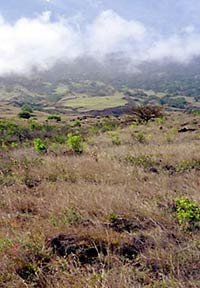UC Berkeley professor heading research in Hawaii in search of clues to sustainability questions
19
December 2001
By
Kathleen Maclay
 |

Manawainui
is an area within the Maui study region where UC Berkeley's
Professor Patrick V. Kirch and his team are exploring
settlement patterns and land use in relation to environmental
variations in the landscape. Photo courtesy of Lisa
Holm. |
Berkeley - A multi-disciplinary team from five universities
is exploring a thousand years of life and history on two Hawaiian
islands, searching for clues to cultural and environmental
sustainability.
Led by University of California, Berkeley, professor Patrick
V. Kirch, widely known for his research on the archaeology
and prehistory of the Pacific Islands, researchers are zeroing
in on the regions of Kohala on the island of Hawaii and Kahikinui
on Maui. Each region features thousands of individual sites
where crews have begun to trace the intricate interactions
between colonizing humans and the environments over a period
ending around 1800.
During that time, the indigenous Polynesian population increased
dramatically in size, sociopolitical complexity emerged within
Hawaiian society, and local physical environments underwent
staggering transformations as farming-based economies took
hold.
"Although the project is focused on the Hawaiian Islands,
the issues addressed are global," said Kirch, the project's
principal investigator. "Many of the cultural and natural
co-evolutionary processes that happened in Hawaii over the
millennium prior to European contact have also happened elsewhere
and are taking place today on a global environmental scale."
Those processes include unprecedented population growth,
widespread deforestation, soil degradation through forest
clearance and nutrient depletion, population migrations into
marginal lands, and increased centralization of political
power and economic control, said Kirch.
National Science Foundation funding is financing 14 "Biocomplexity
in the Environment" research projects. A three-year, $1.4
million grant was issued to UC Berkeley's Archaeological Research
Facility for the Kirch-led team.
Kirch and his fellow researchers hope to produce dynamic
models of the causal and systemic links to changes on the
two islands, models that "can help us understand irreversible
changes driven by the coupling of human and natural systems,"
said Kirch.
Researchers will concentrate on four subjects:
* Agricultural development in the study regions over time
and space
* How human population growth and fluctuations relate to
resource use and agricultural intensification
* Emergence of such sociopolitical complexity as formal control
hierarchies, and the control over labor and surplus
* How growing populations and evolving cultures affect natural
resource bases
"The Hawaiian Islands offer unique opportunities for constraining
analyses of ecosystems, human demography and economics, and
cultural and social responses to environmental change,"
Kirch said.
 |

A
petroglyph from Manawainui, within the study site on
the leeward side of Maui. Photo courtesy of Lisa
Holm. |
Kirch is
a leading authority on the archaeology of the Pacific Islands
and director of UC Berkeley's Phoebe Apperson Hearst Museum
of Anthropology. He also is director of the Oceanic Archaeology
Laboratory at UC Berkeley's Archaeological Research Facility.
He is author
of "On the Road of the Winds: An Archaeological History of
the Pacific Islands before European Contact," published earlier
this year, in which he said most Pacific islands already were
densely populated by the time Europeans arrived to worsen
the human impact on natural ecosystems. Settlement of the
Pacific was one of the fastest human expansions of all time,
Kirch wrote.
Other participants
Kirch chose for the project include archaeologists Michael
Graves of the University of Hawaii and Thegn Ladefoged of
the University of Washington. Both bring years of Hawaiian
research to the project. Kirch has been studying the Kahikinui
site since 1994.
Two major
geographic information system databases will provide a platform
for spatial analysis.
Ecologist
Peter Vitousek of Stanford University, experienced in the
study of Hawaiian ecosystem variability, will work closely
with soil scientist Oliver Chadwick of UC Santa Barbara to
analyze biogeochemical gradients across the study areas. Vegetation
changes over time, including the effects of human land use,
will be explored by assistant professor and co-principal investigator
Sara Hotchkiss of the University of Wisconsin, and by James
Coil of UC Berkeley, who will be a post-doctoral student on
the project.
Shripad
Tuljapurkar of Stanford will spearhead the integration of
the project findings with the use of mathematical modeling
and computer simulation.
###
|